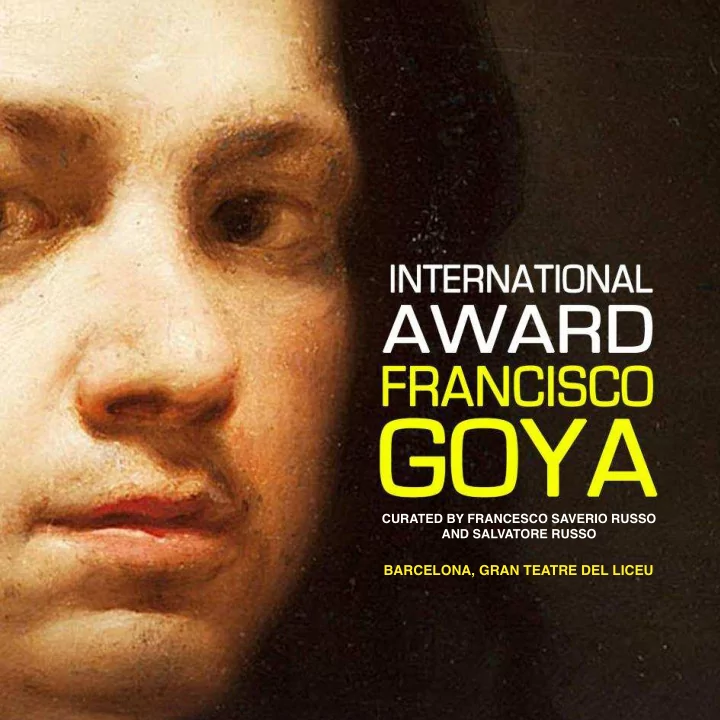

Curated by franCesCo saverio russo and salvatore russo barCelona, Gran teatre del liCeu
La Maja vestjda (1800) Francisco José De Goya y Lucientes was born in coco style tapestry cartoons for the royal palace. Fuendetodos, a small village of Aragon, near Za- of Santa Barbara, a work that will take most of the ragoza, on March 30th, 1746. Fascinated by the art time of his whole life.In 1780 Goya became a mem- of Tiepolo to which he approached in Spain, in 1769 ber of the Royal Academy of San Fernando and in he decided to leave for Italy. Once he came back the following years he realizes a series of oil pain- home, he settled in Zaragoza where he is called to tings whose subjects are toys and children portraits, realize some frescos for the Basilica of Our Lady and in 1784 he also painted one of his most fampus of the Pillar. Thanks to the support of the brothers work, for King’s brother: “ Don Luis’ infant of Bour- in law, the painters Ramòn and Francisco Bayeu, bon family”. In the same period he works for the in 1774 he received the commission to realize Ro- Duke of Osuna working on rural themes for their
country house and on some family portraits.He soon gets sick and becomes deaf, but he carries on his painting activity realizing portraits as “The black duchess” (1795 and 1797), or every day life scenes “The death of picador” (1793), but also the first paintings about insanity, spells and tortures. In 1797 he started working on “Los ca- prichos”, a series of etchings symbol of his ribel- lion against oppression and superstition. Some of his most intense feminine character as “Ma- rìas Tomasa Palafox, Marchioness of Villa- franca” (1804), “Isabel de Porcel” (1804-1805), “La Maya vestida” (1800 – 1805), “ La Maya de- snuda” and “Charles’ IV family” (one of his most famous group portraits), are dated back to the first years of XIX century. The Napoleonic inva- sion of 1808, the cruel reprisals and the tortures of Spanish people, scar the life of Goya, who ex- pressed his pain through the etchings “ War Di- sasters” (1810 – 1820) and through two paintings of 1814: “The second of May 1808” and “The third of May 1808”. Fell in misfortune at court, Goya isolate himself in his country house, “The fifth of deaf”, covering the walls with the so called “black paintings”, distressing and visionary pictures, among which we can remem- ber “ Saturn devouring his sons”. In 1824 he rea- ches France to settle in Bordeaux, the place in which he dies on April 16th, 1828. A detail of The third of May ( 1808)
The artists gifted of an undisputed talent will be awarded with an important prize for their career. The award will be given on the 6th of May 2017, at the Gran Teatre del Liceu, (Mirrors room), of Barcelona, to all those artists who stood out for their artistic value. important personalities of the world of culture and celecbrities will take part to the ceremony. in the May/June number of the magazine “art international Contemporary Magazine”, you’ll find a piece dedi- cated to the artistic talent of francisco Goya; moreover will follow the publication of the artworks by the artists who took part to the event. The Gran Teatre del Liceu has been opened on April 4th, 1847, its starting seating capacity was of 4,000 people and its style has been inspired by Italian one. On April 9th, 1861 a blaze destroyed the hall and the stage, but the restoration, or- ganized by Josep Oriol Mestres, lasted a very few time. On January 31st, 1994 another fire destroyed the whole theatre. The central part of the facade of La Rambla, the main hall with its staircase and the hall of mirrors, have been saved without changing their aspect. The restoration followed the original project: the hall, inspired to the “La Scala” thatre of Milan, is hor- seshoe-shaped with parterre and five floors. Its seating capacity of 2292 spectators, turns i tinto one of the most important theatre in Europe. The decoration of the main hall is the same of the 1909, realized with many-coloured and gilded palsters and the overlapping of different styles from different age, mantain the typical sumptuousness of the theatre of XIX century. Dragon-shaped brass lamps and crystal tulips, wrought-iron and red velvet armchairs, complete this perfect image.
The catalog of the Internatjonal Award “Francisco Goya” will be realized on the basis of the finest typographic rules and highest quality. To every artjst will be dedicated a whole color page. Several copies of the catalog will be given to gallery ow- ners, museum directors, col- lectors and art lovers all over the world.
every artist Will reCeive: - A page into the magazine Art Internatjonal Contemporary Magazine of May – June in the sec- tjon dedicated to the “Internatjonal Award Francisco Goya”. - A page into the official catalog of the event “Internatjonal Award Francisco Goya” - Conferment of the the “Internatjonal Award Francisco Goya” (precious customized plate). - A copy of the magazine “Art Internatjonal Contemporary Magazine”. - A copy of the catalog “Internatjonal Award Francisco Goya”.
Barcelona , Gran teatre del liCeu May 6th, 2017 Info: fra_saverio_russo@hotmail.it +39 331 9760459 or +39 340 9648745
Recommend
More recommend